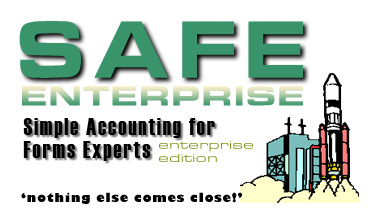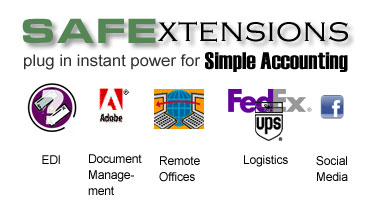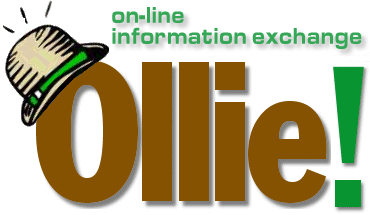 Each sales order begins as a quotation and ends as an invoice (unless you void it or delete it, of course.) After a quote is accepted, you change the status of the transaction to ‘O’. Once an order is invoiced, the system automatically converts the order status to ‘I’ where it cannot be changed. If a printed invoice is voided the status is automatically changed to ‘V’.
Each sales order begins as a quotation and ends as an invoice (unless you void it or delete it, of course.) After a quote is accepted, you change the status of the transaction to ‘O’. Once an order is invoiced, the system automatically converts the order status to ‘I’ where it cannot be changed. If a printed invoice is voided the status is automatically changed to ‘V’.
If you are editing a previously entered transaction and do not need to change any of the information in the Header, you can bypass the remaining fields and proceed directly to the Line Items. However, this will only work while editing an existing order; you must fill in each field for new transactions.
Special Browse Columns
The first four columns of the line item browse are especially important:
| ! Tagged | Tag line items for printing a Purchase Order. If the order is tagged youll see a green check mark.Remember: You must have at least one line item tagged in order to print a Purchase Order. |
| A Posted To A/P? | If this line has already been posted to A/P, you will see a check in this column. |
| S Status | Indicates where in the workflow is an individual Line Item. Normally, the status of a Line Item will match that of the Order (for example Acknowledged. However, on multi-line item orders, each Line Item may be in a completely independent phase of production and delivery.When the Line Item is considered released from inventory (either because a Release Notice or a Customer Invoice has been printed) inventory is updated in SAFE to reflect that inventory has been relieved. This is indicated in the Line Item Status with an ‘S’ (for Shipped.)
You can also double click on this column and manually override this status. If the line item is marked Complete, then you must untag this column in order to make changes to the line which will update the Product Master such as numbering and the Last Vendor Job ID. |
| # Line Item Position | Indicates the position of the Line Itemin the browse (and also the order it will print on any forms such as Packing Slips and Invoices.TIP: You can change the position of any line item by pressing the + or keys as described below. |
Special Buttons
| [Print] | Print purchase orders, RFQs and other forms for the tagged line items on this sale. If only one item is tagged, you can print either a purchase order oran RFQ for the line items selected vendor.
If you need to get quotes from more than one vendor, youll need to go to Products or the RFQs Browse. If you have tagged more than one line item, you can generate (or re-print) purchases orders for all tagged items. Items assigned to a the same vendor are grouped on the same purchase order (but they all still refer back to your sales order number.) We think that last sentence bears repeating!No matter how many line items on a sales order, to however many vendors. And no matter how many P.O.s, they all will print with the same Sales Order ID which carries forward into A/P. That way you will always know which items were part of which job; by Sales Order ID, of course. If the line items are for custom jobs, when you invoice the customer, the purchase order(s) generated here will automatically be completed and new bill(s) posted to the Vendor Invoices browse! Once you print a purchase order, you may not change the vendor ID or Vendor Quote #. If you make a mistake in either field, you must go to the Purchase Orders Browse and void the P.O. in order to change these. (So many notes!) Generating a purchase order, automatically saves the sales order. |
[Activities]  |
Lists the Activities linked to this particular sales order. These can be tracked for the Contact to which they are linked and to any Vendor Bills and Vendor P.O.s linked to the same Sales Order ID. |
| Clone | This creates a new order which is a copy of the currently selected order. |
| Commissions | Press this button to view or edit commissions for this order. |
| Notes | Press this button to add or edit Customer or Vendor Notes for this line item. |
| [Tag All] | Automatically tag all records for this sales order. |
Special Keystrokes
| Ctrl/Space [Tag] | Tag the line item for printing a purchase order. At least one line item must be tagged in order to be able to print a P.O. here. |
| [Tag] (A/P Post Column) | Tag the Line Item as having been posted to A/P. This prevents the Line Item from being accidentally posted twice to A/P if you have already entered it manually into the Bills Browse. |
| +/- | Changes the Line Item Position. This moves the order of Sales Order Line Items in the Browse and on Forms such as Packing Slips and Invoices. In other words, if you add a line item to a Sales Order, you can make it appear as the first line of the transaction. |
| [Tag] (Status Column) | Manually sets the Status of each Line Item on the Sales Order from adrop-down-list. Normally, the Status of each Line Item follows that of the Sales Order Status. You can override this in cases where there are multiple Line Items and each is in a different phase of production. |
Header Fields
GENERAL TAB
Most of these fields are required on every order.
| CUSTOMER ID | The customer ID from the FILES|Customers. You can search for a Customer ID by pressing the field lookup button to bring up a browse box.When you enter a valid Customer ID, the Name and Address appears on the screen in the upper-left window.
If any Billing Notes have been entered for this customer in the Customer Main Data File, they will be displayed in a NoteTaker Window at the lower left of the screen. If you have entered a custom warning formula in Sales & A/R Options, these notes will also appear here. If Billing Notes are visible, you can also allow users to view Customer Aging.
From the customer browse you can press the [Contacts] button to convert a prospect into a live customer for their first order by selecting a contact and pressing [Convert]. |
| REPRESENTATIVE EMPLOYEE ID | The Employee ID. This must be a valid record from theFILES|Representatives & Employees. You should probably set up an in-house ID to cover sales not applicable to any particular sales person. Press the field lookup button to select from a browse box. |
| TERMS ID | Enter the payment terms for this transaction from the terms main data file. A browse is available by pressing the field lookup button. |
| COMMISSION TABLE ID | Enter an ID from your Commission Tablehere if this order is subject to special commission, ie. The commission to be credited is different from the default formula used for the Sales Person(s) assigned to the order. Assigning a Commission Table to an order overrides the default formula, forcing the order to use the commission formula set up with that Commission Table. Leave this field blank unless this is a special case.Example: Your salespeople are given a particular incentive bonus for all sales within the month of April. Rather than re-set all default commissions, you simply create a Commission Table reflecting the special incentive and instruct your data entry people to use this Commission Table during order entry for all orders during April.
Sales Representative John Hamilton receives a special type of order from a large customer every three months. The terms of the order make it impossible to pay John fairly according to your default commission structure. You create a special Commission Table for this type of order and use it only when this customer places their large quarterly orders. All line items on a sales order use the same Commission Table formula. You cannot assign different Commission Tables for a single line item.
|
| ORDER ID | Your in-house order identification. This field is copied into Vendor Invoices and Purchase Orderslinked to this order so you can track every aspect of the job with the same number.The Sales Order ID can be automatically assigned for you using a simple formula you create in Setup Global Options on the Record Numbering Tab.
The Sales Order ID is probably the single most important field in Simple Accounting. It is the link between sales orders and their A/P invoices.
|
| TRANSACTION ID | The program’s internal identifier. This field is especially important since you will use this number along with the Customer ID as the key to retrieve this transaction for editing and invoicing later. |
| MARK UP | This field reminds you of the customer’s Mark-Up Percentage, set in the (non-editing) customer’s main data file. This percentage will be added to (or subtracted from) each item’s sale price. A plus sign (+) indicates that the price will be marked up, a minus sign (-) indicates that the price will be marked down by the percentage. |
| CUSTOMER REFERENCE | The customer’s purchase order number. Entry not required. |
| ORDERED | The date the order is entered. |
| ACKNOWLEDGE DATE | The acknowledged shipping date from the Vendor. If blank, Simple Accounting assumes that the order has not been acknowledged. If you enter another date, the program assumes that you have received an acknowledgement and will then allow you to print a Customer Acknowledgement Notice for this order. |
| SHIP DATE | The intended delivery date to the Customer. You should adjust this date, if necessary, before invoicing. |
| ORDER STATUS | This field contains the current status of the sales order transaction. Normally you do not change this field yourself, but let Simple Accounting do so for you as the order is processed.
The color of an order in the Sales Order Browse is detemined by its Order Status. |
| Q | A quote which has not been accepted as a live order. You cannot enter ship quantities in with its line items. |
| O | A live order. Shipped quantities may be entered in to its line items and it can be invoiced. |
| A | An order for which an acknowledgement date has been entered. The order is automatically updated to this status when an acknowledgement is been printed. |
| K | Backordered. The transaction was created automatically from an order which was partially billed. The back order transaction has the same Sales Order ID as the original, but only the lines which were incomplete when the original was invoiced.
By default, a backordered is create if any line items are shipped with less than 90% of the order quantity. Ninety percent is the default. You can change the back order percentage in Simple Accounting Security Extensions under the Custom Settings menu. |
| P | A packing slip has been generated for this order. The Order Quantity has been added to the Committed Quantity for each Product. |
| S | An order which has shipped but which has not yet been billed. The order is automatically changed to this status after a Packing Slip is printed. |
| L | The order is Locked, meaning that only users with the proper Security may edit the order. This is important users of Remote Office Extensions to prevent remote office users from overwriting changes made at the home office just before billing. |
| I | An active invoiced order waiting to be posted to history. The status is automatically converted to ‘I’ when you print the order as an invoice. |
| V | An invoiced order that has been voided.
Once an order is invoiced, it may not be edited!
|
| INVOICE DATE | The date to appear on the customer invoice. The default is today’s date, but you can back date or enter a future date if you wish. |
| ORDER TYPE | This field indicates if this is a new order or a repeat order with or without changes. The LAST REVISED DATE field for all Productson this order is updated unless the ORDER TYPE is (E)xact Repeat.C Changed Copy, same spec
E Exact Repeat of this customers job N New Order, first time R Release from existing Customer Owned or Distributor Owned stock. S Changed spec, same copy B Summary Bill. Summary Bills may be printed from the Sales Order Browse, but cannot be edited there. To edit a Summary Bill, go to the Customer Browse, select the customer and press [Print|Summary Bills]. If you have Simple Accounting Security Extensions, you may select a separate numbering sequence for Releases (Sales Orders with ORDER TYPE = R). |
BILLING ADDRESS & CUSTOMER NOTES TAB
| SHIP IN NAME OF | This field is used when processing orders for a third party where the third party should appear to the end customer as the vendor. If this appears on the purchase order, the manufacturer can then label the order as having shipped in the name of this third party. The default is your company name. |
| NAME | The name, address and phone/fax numbers are as they appear in the Customer Browse. They can only be edited if you the Customer ID is CASH (your One-Time Customer ID.) |
| ADDRESS | The customers bill to company address as it appears in the Customer Main Data File. |
| PHONE # | The customer company main phone number as it appears in the Customer Main Data File. |
| FAX # | The customers fax phone number as it appears in the Customer Main Data File. |
| CONTACT | Enter the contact person for this order. This field defaults to the customer’s Billing Contact in FILES|Customers, but is updated with the contact name of the shipping address if an alternate shipping address (site) is selected. This field is stored with the order in sales history for repeats. It appears as the Contact Name on any printed forms (Purchase Orders, Invoices, etc.) |
| SALES ORDER NOTES | Notes which describe the sales order as a whole. These print on the footer of invoices if your invoice is designed to print them.
This is a separate field from the Customer Notes attached to each Sales Order Line Item. |




 This button activates a [tooltip slug="browse-box"]browse box[/tooltip]. It is always placed directly to the right of an entry field and allows you to select a value for the entry field from the browse box. The browse box usually has all the same functions as if you had selected it from the main menu, so you can add, edit or delete records in the browse without leaving your original task.
This button activates a [tooltip slug="browse-box"]browse box[/tooltip]. It is always placed directly to the right of an entry field and allows you to select a value for the entry field from the browse box. The browse box usually has all the same functions as if you had selected it from the main menu, so you can add, edit or delete records in the browse without leaving your original task. Pressing <F6> on your keyboard when you are in a field with a lookup button works the same as pressing the Field Lookup button itself!
Pressing <F6> on your keyboard when you are in a field with a lookup button works the same as pressing the Field Lookup button itself!